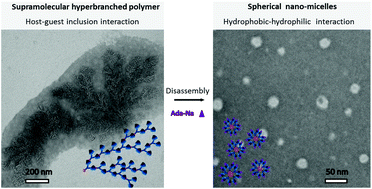Morphology transitions of supramolecular hyperbranched polymers induced by double supramolecular driving forces†
Abstract
Tuning the morphology of supramolecular hyperbranched polymers (SHPs) in solution has theoretical and practical significance in SHP applications. This study successfully achieved SHP morphology transitions from branched supramolecular structures to spherical nanosized micelles in mixed solvents. Transmission electron microscopy, dynamic light scattering, 2D 1H NMR ROESY, and fluorescence emission spectroscopy confirmed these transitions. An AB2-type amphiphilic β-cyclodextrin (β-CD) monomer (Ada-CD2) exhibiting double supramolecular interactions was initially synthesized. SHPs based on Ada-CD2 were then formed in DMF–H2O mixed solvents through the host–guest inclusion interaction between β-CD and Ada. The formed SHPs disassembled with the addition of adamantane carboxylic sodium salt, which was a competitive guest. The SHPs reassembled into core–shell structured micelles based on the hydrophilic–hydrophobic interaction of the amphiphilic Ada-CD2 monomer.


 Please wait while we load your content...
Please wait while we load your content...